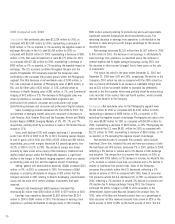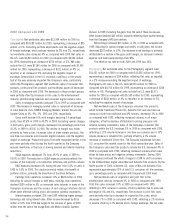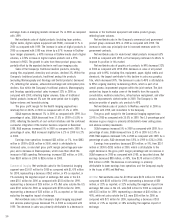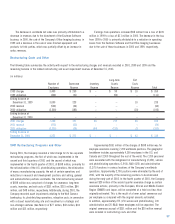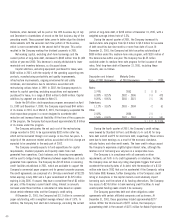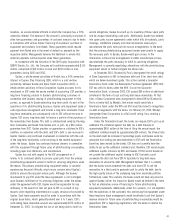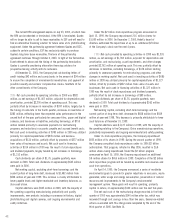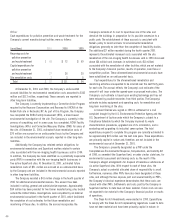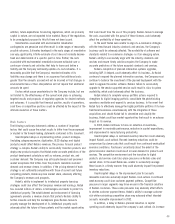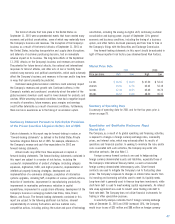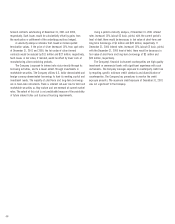Kodak 2001 Annual Report Download - page 41
Download and view the complete annual report
Please find page 41 of the 2001 Kodak annual report below. You can navigate through the pages in the report by either clicking on the pages listed below, or by using the keyword search tool below to find specific information within the annual report.
39
of this slowdown. These actions include efforts to better manage
production and inventory levels and reduce capital spending, while at the
same time reducing discretionary spending to further hold down costs.
The Company will also complete the implementation of the restructuring
programs announced in 2001 to make its operations more cost
competitive and improve margins, particularly in its health imaging and
consumer digital camera businesses.
During 2000, the Company completed an ongoing program of real
estate divestitures and portfolio rationalization that contributed to other
income (charges) reaching an annual average of $100 million over the
past three years. Now that this program is largely complete, the other
income (charges) category is expected to run in the negative $50 million
to negative $100 million range annually.
The Company expects its effective tax rate to approximate 29% in
2002. The lower rate is attributable to favorable tax benefits from the
elimination of goodwill amortization and expected increased earnings
from operations in certain lower-taxed jurisdictions outside the U.S.
From a liquidity and capital resource perspective, the Company
expects to generate $6 billion in cash flow after dividends during the
next six years, with approximately $400 million of this being achieved in
2002. This will enable the Company to maintain its dividend, pay down
debt and make acquisitions that promote profitable growth. Cash flow is
defined as net cash flows (after dividends), excluding the impacts from
debt and transactions in the Company’s own equity, such as stock
repurchases and proceeds from the exercise of stock options.
The Euro
The Treaty on European Union provided that an economic and monetary
union (EMU) be established in Europe whereby a single European
currency, the Euro, replaces the currencies of participating member
states. The Euro was introduced on January 1, 1999, at which time the
value of participating member state currencies was irrevocably fixed
against the Euro and the European Currency Unit (ECU) was replaced at
the rate of one Euro to one ECU. For the three-year transitional period
ending December 31, 2001, the national currencies of member states
continued to circulate, but as sub-units of the Euro. New public debt was
issued in Euros and existing debt was redenominated into Euros. At the
end of the transitional period, Euro banknotes and coins were issued,
and the national currencies of the member states will cease to be legal
tender no later than June 30, 2002. The countries that adopted the Euro
on January 1, 1999 were Austria, Belgium, Finland, France, Germany,
Ireland, Italy, Luxembourg, The Netherlands, Portugal, and Spain. Greece
was part of the transition. The Company has operations in all of these
countries.
As a result of the Euro conversion, it is possible that selling prices
of the Company’s products and services will experience downward
pressure, as current price variations among countries are reduced due to
easy comparability of Euro prices across countries. Prices will tend to
harmonize, although value-added taxes and transportation costs will still
justify price differentials. Adoption of the Euro will probably accelerate
existing market and pricing trends including pan-European buying and
general price erosion.
On the other hand, currency exchange and hedging costs will be
reduced; lower prices and pan-European buying will benefit the Company
in its purchasing endeavors; the number of banks and suppliers needed
will be reduced; there will be less variation in payment terms; and it will
be easier for the Company to expand into new marketing channels such
as mail-order and Internet marketing.
The Company made changes in areas such as marketing and
pricing, purchasing, contracts, payroll, taxes, cash management and
treasury operations. Under the “no compulsion no prohibition” rules,
billing systems were modified so that the Company is able to show total
gross, value-added tax, and net in Euros on national currency invoices.
This enables customers to pay in the new Euro currency if they wish to
do so. Countries that have installed ERP/SAP software in connection with
the Company’s enterprise resource planning project are able to invoice
and receive payments in Euros as well as in other currencies. Systems for
pricing, payroll and expense reimbursements continued to use national
currencies until year-end 2001. The functional currencies in the affected
countries were the national currencies until May 2001 (except Germany
and Austria (October 2001)), when they changed to the Euro. Systems
changes for countries not on SAP (Finland and Greece) were implemented
in 2001.
Liquidity and Capital Resources
2001 Net cash provided by operating activities in 2001 was $2,065
million, as net earnings of $76 million, adjusted for depreciation and
amortization, and restructuring costs, asset impairments and other
charges provided $1,825 million of operating cash. Also contributing to
operating cash was a decrease in receivables of $252 million and a
decrease in inventories of $461 million. This was partially offset by
decreases in liabilities, excluding borrowings, of $529 million related
primarily to severance payments for restructuring programs and
reductions in accounts payable and accrued benefit costs. Net cash used
in investing activities of $1,047 million in 2001 was utilized primarily for
capital expenditures of $743 million and business acquisitions of $306
million. Net cash used in financing activities of $808 million in 2001
was primarily the result of stock repurchases and dividend payments as
discussed below.
The Company declared cash dividends per share of $.44 in each of
the first three quarters and $.89 in the fourth quarter of 2001. Total cash
dividends of $643 million were paid in 2001. In October 2001, the
Company’s Board of Directors approved a change in dividend policy
from quarterly dividend payments to semi-annual dividend payments.



